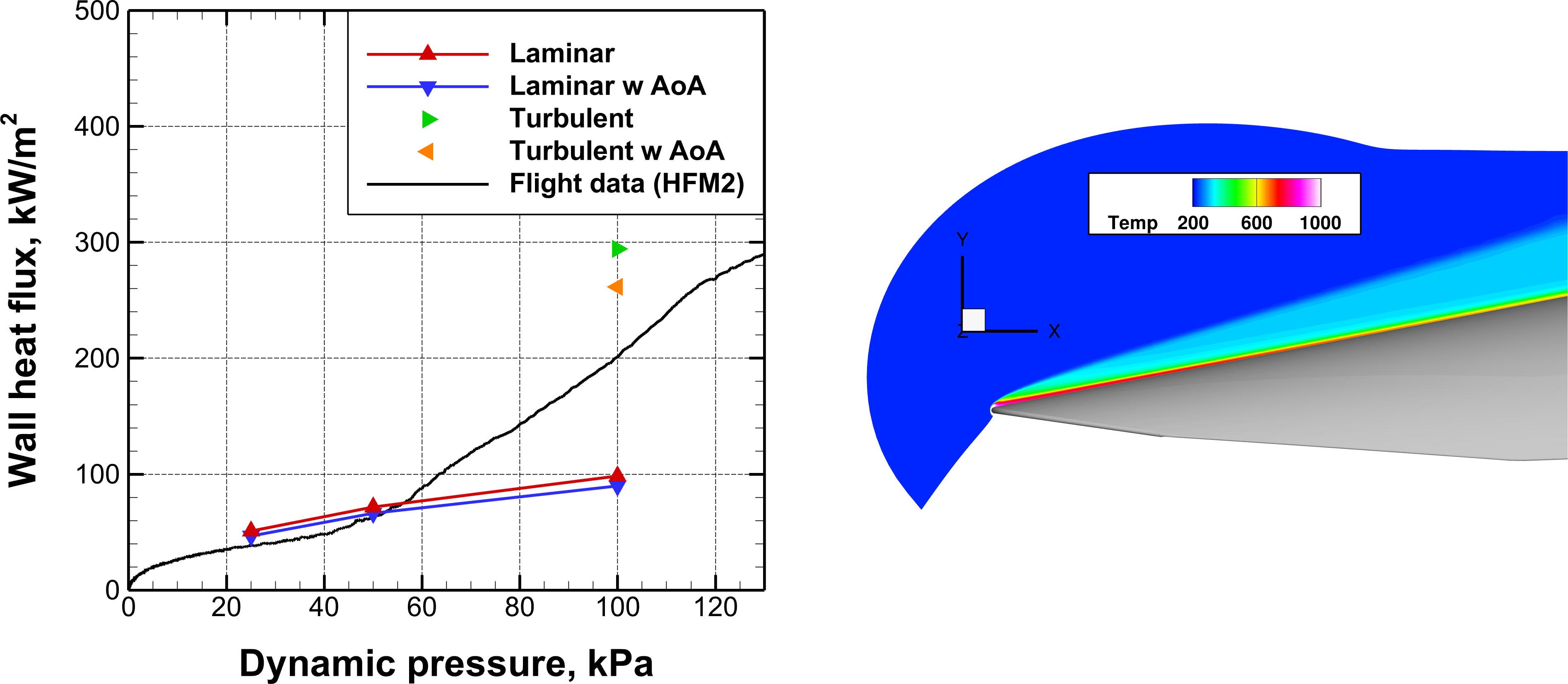Research and development of prediction technology for thermal and aerodynamic characteristics of hypersonic vehicle
JAXA Supercomputer System Annual Report February 2024-January 2025
Report Number: R24EDA201G20
Subject Category: Aeronautical Technology
- Responsible Representative: Kazuyuki Nakakita, Aviation Technology Directorate, Fundamental Aeronautics Research Unit
- Contact Information: matsuyama.shingo@jaxa.jp(matsuyama.shingo@jaxa.jp)
- Members: Keisuke Fujii, Shingo Matsuyama, Hidemi Takahashi, Takahiro Yamamoto
Abstract
Strong shock waves are generated around a flying object at hypersonic speeds, and the high-temperature gas compressed by the shock waves causes strong heat transfer to the hypersonic vehicle. The objective of this research is to establish a technique to reproduce such a flow field around a hypersonic vehicle by CFD and to accurately evaluate the aerodynamics and heating applied to the vechicle.
Reference URL
N/A
Reasons and benefits of using JAXA Supercomputer System
The flight conditions of hypersonic vehicles often have high Reynolds numbers, which necessitates the evaluation of turbulent heating. Since this study aims to evaluate turbulent heating with high accuracy using Direct Numerical Simulation (DNS) and Large Eddy Simulation (LES), a three-dimensional unsteady analysis is inevitably required. The computational cost of such a large-scale three-dimensional analysis is very high, and analysis using a supercomputer is essential.
Achievements of the Year
CFD analyses were conducted for the S-520-RD1 flight experiment and the reusable sounding rocket (ATRIUM) to verify the prediction accuracy and identify issues related to various interfering flows (shock wave interference with the rudder surface, intake flow, etc.) that occur in the flow field around hypersonic vehicles. The following is a brief list and summary of the results obtained.
- Laminar flow analysis and RANS analysis assuming full turbulence were performed for the flight conditions of S-520-RD1 to reproduce the trend of heat flux data obtained from the flight experiment (heat flux shifts from laminar to turbulent values as the flow dynamic pressure increases) (Figure 1).
- Unsteady analyses using LES were performed on the wind tunnel test for the ATRIUM intake geometry to reproduce the measured wall pressure data under three Mach number conditions. LES also reproduced the trend observed in the wind tunnel tests of the intake unstarting (M = 1.5, 2.0) and starting (M = 2.5) (Figure 2).

Fig.1: Results of CFD analysis on the S-520-RD1 flight experiment. Comparison of heat flux values at the sensor HFM2 location (left panel), and temperature distribution of the flow field around the vehicle (right panel).

Fig.2: Results of LES analysis for intake geometry of ATRIUM. From left to right, instantaneous pressure fields are shown for the conditions M = 1.5, 2.0, and 2.5.
Publications
- Non peer-reviewed papers
1) Shingo Matsuyama, "Workshop on Post-Flight Analysis of S-520-RD1 Flight Test Data," Proceedings of the 56th Fluid Dynamics Conference / the 42nd Aerospace Numerical Simulation Symposium, SP-24-006, p. 93-103, 2025.
- Oral Presentations
1) Shingo Matsuyama, “Workshop on Post-Flight Analysis of S-520-RD1 Flight Test Data,” Proceedings of the 56th Fluid Dynamics Conference / the 42nd Aerospace Numerical Simulation Symposium: 2024.
2) Shingo Matsuyama, Yuki Ide, Keisuke Fujii, "DNS of Hypersonic Boundary Layer Transition Solving the Whole Wind Tunnel Nozzle and Model," Symposium on Flight Mechanics and Astrodynamics: 2024.
3) Shingo Matsuyama, "Some Considerations for Performing High-Fidelity DNS of Boundary Layer Transitions Encountered During Actual Atmospheric Entries," Symposium on Flight Mechanics and Astrodynamics: 2024.
Usage of JSS
Computational Information
- Process Parallelization Methods: MPI
- Thread Parallelization Methods: OpenMP
- Number of Processes: 576 - 32680
- Elapsed Time per Case: 100 Hour(s)
JSS3 Resources Used
Fraction of Usage in Total Resources*1(%): 1.21
Details
Please refer to System Configuration of JSS3 for the system configuration and major specifications of JSS3.
| System Name | CPU Resources Used(Core x Hours) | Fraction of Usage*2(%) |
|---|---|---|
| TOKI-SORA | 30788788.80 | 1.41 |
| TOKI-ST | 16470.41 | 0.02 |
| TOKI-GP | 0.00 | 0.00 |
| TOKI-XM | 0.00 | 0.00 |
| TOKI-LM | 232105.59 | 16.75 |
| TOKI-TST | 52554.02 | 0.94 |
| TOKI-TGP | 0.00 | 0.00 |
| TOKI-TLM | 0.00 | 0.00 |
| File System Name | Storage Assigned(GiB) | Fraction of Usage*2(%) |
|---|---|---|
| /home | 1362.46 | 0.92 |
| /data and /data2 | 105326.75 | 0.50 |
| /ssd | 31433.00 | 1.68 |
| Archiver Name | Storage Used(TiB) | Fraction of Usage*2(%) |
|---|---|---|
| J-SPACE | 4.48 | 0.01 |
*1: Fraction of Usage in Total Resources: Weighted average of three resource types (Computing, File System, and Archiver).
*2: Fraction of Usage:Percentage of usage relative to each resource used in one year.
ISV Software Licenses Used
| ISV Software Licenses Used(Hours) | Fraction of Usage*2(%) | |
|---|---|---|
| ISV Software Licenses(Total) | 1325.62 | 0.91 |
*2: Fraction of Usage:Percentage of usage relative to each resource used in one year.
JAXA Supercomputer System Annual Report February 2024-January 2025


